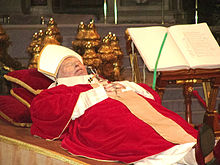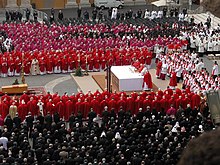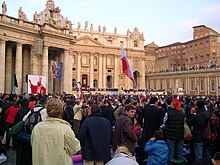Funeral of John Paul II
The funeral of Pope John Paul II took place on April 8, 2005. Six days earlier, on April 2, 2005, the head of the Catholic Church had died after more than 26 years in office.
Papal funeral rite
Centuries-old traditions and rituals are used at the funeral of a deceased Pope.
Death of the Pope
The death of the Pope is determined by the Camerlengo . This is always the same: the Cardinal Chamberlain enters the Pope's bedroom accompanied by a guard of the Swiss Guard armed with halberds (as a sign of the authority that has been transferred to him) in the presence of the ceremonial, the prelates and the secretary and chancellor of the Apostolic Chamber. The Camerlengo officially declares the death of the Pope. After that, the secretary and chancellor of the Apostolic Chamber immediately issues an official death certificate (the cause of death does not have to be named, an autopsy does not have to be ordered). Following an old ritual, he addressed him twice by his baptismal name. Eduardo Martínez Somalo then removed the fishing ring and destroyed it in front of the College of Cardinals . This ensured that no documents could be forged and issued in the name of John Paul II. After the fishing ring was destroyed, the Camerlengo sealed the Pope's private apartments with wax seals so that no one could enter them. The death certificate was issued by Dr. Renato Buzzonetti exhibited. Thereupon the cardinals all over the world were called together by the cardinal dean Joseph Cardinal Ratzinger in order to elect a new pope in the conclave . In contrast to his predecessors, John Paul II did not use embalming . The request that the limbs or the heart be buried in Poland was also contradicted.
burial
After the death of the Pope, accompanied by extensive media coverage, there were meetings in many larger metropolises and finally a huge pilgrimage to Rome, where the body was laid out on the evening of April 4, 2005. During the first day, half a million people paid their last respects to the late Pope.
Funeral mass
3.5 million pilgrims came to Rome for the exequies on April 8, 2005 in St. Peter's Square, many of them from Poland. The Pope has to be buried between the fourth and sixth day after his death, which is why the College of Cardinals decided on Friday. 200 heads of state and government and high spiritual representatives of different religions attended the celebration. The guests included the Ecumenical Patriarch of Constantinople Bartholomew I , the Metropolitan of Smolensk and Kaliningrad Kyrill I as a representative of the Foreign Office of the Russian Orthodox Church , the founder and prior of the Taizé Community, Brother Roger Schutz and the then Pope of the Coptic Church , Schenuda III. The funeral mass was also broadcast on television almost worldwide. The ceremony was watched by probably over two billion people worldwide. This made the funeral the largest documented funeral that has ever taken place. At the same time, it was one of the most haunted, if not the most watched, events in telecommunications history.
procession
The funeral procession began behind closed doors in St. Peter's Basilica. Only the college of cardinals and some high-ranking bishops were allowed to attend. The Pope was placed in a cypress coffin and Stanisław Dziwisz put a white veil over the body; this was his last act as papal private secretary. The coffin was then sealed and the gates of St. Peter's Basilica opened.
Liturgy of the funeral mass
The word service formed the beginning of the mass . This was the first reading from the Acts of the Apostles , which was followed by Psalms 22 and 23 . The second reading was from Paul's letter to the Philippians . The gospel reading was proclaimed from the gospel according to John . The Gospel was followed by the sermon of Cardinal Ratzinger, in which he discussed important stages in the life of John Paul II. This was followed by the celebration of the Eucharist . The mass ended with the In paradisum .
burial
John Paul II was buried closed to the public in the papal crypt of St. Peter's Basilica at the place where John XXIII was buried until his reburial in 2001 . had been. There were voices from his home country, Poland, calling for a burial or at least a burial of the heart in Poland. However, in his will, John Paul II left the decision about the burial circumstances to the College of Cardinals, which decided to have the burial in Rome.
The zinc coffin was heaved into a larger coffin made of walnut wood (traditionally elm wood ), which was closed with nails made of pure gold . The outer coffin was decorated with three bronze plaques: a simple cross on the front of the coffin, a central plaque with the name of the Pope and the duration of the earthly existence and the duration of the pontificate, and a third with the coat of arms of John Paul II on the feet. The middle plaque contains the following inscription in Latin:
VIXIT ANNOS LXXXIV MENSES X DIES XV
ECCLESIAE UNIVERSAE PRAEFUIT
Here lies the corpus of John Paul II, Pontifex Maximus
He lived 84 years, 10 months, 15 days.
He presided over the entire Church
Safety measures
Due to the large number of pilgrims and guests of honor gathered, there was fear of terrorist attacks. On April 6, for example, a restricted flight area was set up over Rome and the Italian armed forces and the Italian police were put on alert. In addition, the Rome Ciampino and Rome Fiumicino airports and some smaller local airports were closed.
Web links
Individual evidence
- ↑ Süddeutsche Zeitung
- ^ CNN Transcript
- ^ CNN Transcript
- ↑ BBC (English).




